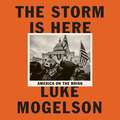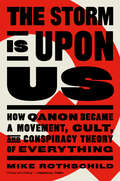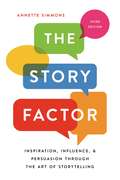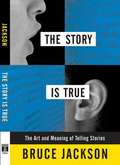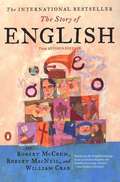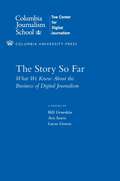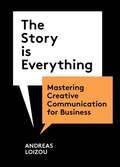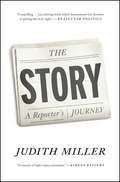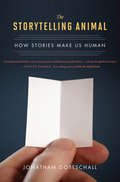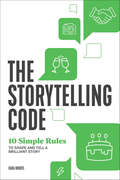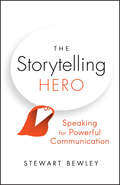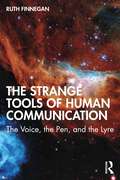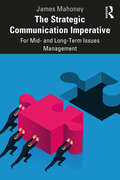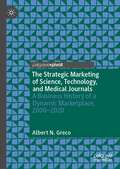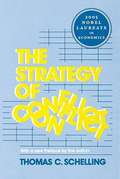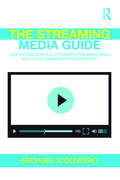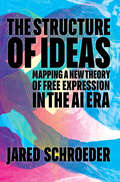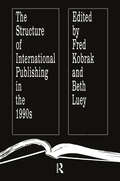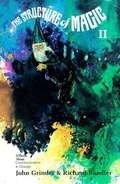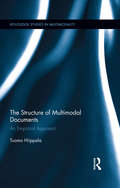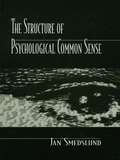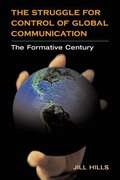- Table View
- List View
The Storm is Here: America on the Brink
by Luke MogelsonThe Storm is Here is a record of a year that changed America.The New Yorker's award-winning war correspondent returns to his own country to chronicle a story of mounting civic breakdown and violent disorder, in a vivid eyewitness narrative of revelatory explanatory powerOn the morning of January 6, a gallows was erected on the National Mall in Washington, D.C. A little after noon, as thousands of Trump supporters marched past the structure, some paused to climb its wooden steps and take pictures of the US Capitol framed within an oval noose. Up ahead, the dull thud of stun grenades could be heard, accompanied by bright flashes. Several people carried Confederate flags. Others had Tasers, baseball bats, bear spray, and truncheons. 'They need help!' a man shouted. 'It's us versus the cops!' No one seemed surprised by what was taking place. There was an eerie sense of inexorability, mixed with nervous hesitation. It reminded me of combat: the slightly shocked, almost bashful moment when bravado, fantasy, and training crash against reality.In early 2020, Luke Mogelson, who had been living in France and covering the Global War on Terrorism, returned home to report on the social discord that the pandemic was bringing to the fore in the US. Soon, he found himself embedded with militias descending on the Michigan state capitol. From there, the story swept him on to Minneapolis, then to Portland, and ultimately to Washington, D.C. His stories for The New Yorker were hailed as essential first drafts of history. They were just the tip of the iceberg.The Storm Is Here is the definitive eyewitness account of how--during a season of sickness, economic uncertainty, and violence--a large segment of Americans became convinced that they needed to rise up against dark forces plotting to take their country away from them, and then did just that. It builds month by month, through vivid depictions of events on the ground, from the onset of the pandemic to the attack on the US Capitol--during which Mogelson was in the Senate chamber with the insurrectionists--and its aftermath. Bravely reported and beautifully written, Mogelson's audiobook follows the tradition of some of the essential chronicles of war and unrest of our time.(P) 2022 Penguin Audio
The Storm is Upon Us: How QAnon Became a Movement, Cult, and Conspiracy Theory of Everything
by Mike Rothschild"An ideal tour guide for your journey into the depths of the rabbit hole that is QAnon. It even shows you a glimmer of light at the exit." —Cullen Hoback, director of HBO's Q: Into the Storm Its messaging can seem cryptic, even nonsensical, yet for tens of thousands of people, it explains everything: What is QAnon, where did it come from, and is the Capitol insurgency a sign of where it&’s going next? On October 5th, 2017, President Trump made a cryptic remark in the State Dining Room at a gathering of military officials. He said it felt like &“the calm before the storm&”—then refused to elaborate as puzzled journalists asked him to explain. But on the infamous message boards of 4chan, a mysterious poster going by &“Q Clearance Patriot,&” who claimed to be in &“military intelligence,&” began the elaboration on their own. In the days that followed, Q&’s wild yarn explaining Trump's remarks began to rival the sinister intricacies of a Tom Clancy novel, while satisfying the deepest desires of MAGA-America. But did any of what Q predicted come to pass? No. Did that stop people from clinging to every word they were reading, expanding its mythology, and promoting it wider and wider? No. Why not? Who were these rapt listeners? How do they reconcile their worldview with the America they see around them? Why do their numbers keep growing? Mike Rothschild, a journalist specializing in conspiracy theories, has been collecting their stories for years, and through interviews with QAnon converts, apostates, and victims, as well as psychologists, sociologists, and academics, he is uniquely equipped to explain the movement and its followers. In The Storm Is Upon Us, he takes readers from the background conspiracies and cults that fed the Q phenomenon, to its embrace by right-wing media and Donald Trump, through the rending of families as loved ones became addicted to Q&’s increasingly violent rhetoric, to the storming of the Capitol, and on. And as the phenomenon shows no sign of calming despite Trump&’s loss of the presidency—with everyone from Baby Boomers to Millennial moms proving susceptible to its messaging—and politicians starting to openly espouse its ideology, Rothschild makes a compelling case that mocking the seeming madness of QAnon will get us nowhere. Rather, his impassioned reportage makes clear it's time to figure out what QAnon really is — because QAnon and its relentlessly dark theory of everything isn&’t done yet.
The Story Factor: Inspiration, Influence, and Persuasion through the Art of Storytelling
by Annette SimmonsFully revised, updated, and expanded, this modern classic will teach you to use the art of storytelling to persuade, motivate, and inspire in life and business Anyone seeking to influence others must first know their own story, and how to tell it properly. Whether you're proposing a risky new venture, trying to close a deal, or leading a charge against injustice, you have a story to tell. Tell it well and you will create a shared experience with your listeners that can have profound results.In this modern classic, Annette Simmons reminds us that the oldest tool of influence is also the most powerful. Fully revised and updated to account for new technology and social media, along with two new chapters on the role of stories in the development of civilization and how to adjust your story to your specific goal, Simmons showcases over a hundred examples of effective storytelling drawn from the front lines of business and government, as well as myths, fables, and parables from around the world. Whether writing a screenplay, or announcing a corporate reorganization, Simmons illustrates how story can be used in ways that cold facts, bullet points, and directives can't. These stories, combined with practical storytelling techniques, show anyone how to become a more effective communicator and achieve their goals.
The Story Is True: The Art and Meaning of Telling Stories
by Bruce JacksonMaking and experiencing stories, remembering and retelling them is something we all do. We tell stories over meals, at the water cooler, and to both friends and strangers. But how do stories work? What is it about telling and listening to stories that unites us? And, importantly, how do we change them-and how do they change us? InThe Story Is True, author, filmmaker, and photographer Bruce Jackson explores the ways we use the stories that become a central part of our public and private lives. He examines, as no one before has, how stories narrate and bring meaning to our lives, by describing and explaining how stories are made and used. The perspectives shared in this engaging book come from the tellers, writers, filmmakers, listeners, and watchers who create and consume stories. Jackson writes about his family and friends, acquaintances and experiences, focusing on more than a dozen personal stories, from oral histories, such as conversations the author had with poet Steven Spender, to public stories, such as what happened when Bob Dylan "went electric"at the 1965 Newport Folk Festival. Jackson also investigates how "words can kill," showing how diction can be an administrator of death, as in Nazi extermination camps. And finally, he considers the way lies come to resemble truth, showing how the stories we tell, whether true or not, resemble truth to the teller. Ultimately,The Story Is Trueis about the place of stories-fiction or real-and the impact they have on the lives of each one of us.
The Story Of English, Third Revised Edition
by Robert Macneil Robert Mccrum William CranNow revised, The Story of English is the first book to tell the whole story of the English language. Originally paired with a major PBS miniseries, this book presents a stimulating and comprehensive record of spoken and written English—from its Anglo-Saxon origins some two thousand years ago to the present day, when English is the dominant language of commerce and culture with more than one billion English speakers around the world. From Cockney, Scouse, and Scots to Gulla, Singlish, Franglais, and the latest African American slang, this sweeping history of the English language is the essential introduction for anyone who wants to know more about our common tongue.
The Story So Far: What We Know About the Business of Digital Journalism (Columbia Journalism Review Books)
by Ava Seave Bill Grueskin Lucas GravesBill Grueskin, Ava Seave, and Lucas Graves spent close to a year tracking the reporting of on-site news organizations-some of which were founded over a century ago and others established only in the past year or two-and found in their traffic and audience engagement patterns, allocation of resources, and revenue streams ways to increase the profits of digital journalism. In chapters covering a range of concerns, from advertising models and alternative platforms to the success of paywalls, the benefits and drawbacks to aggregation, and the character of emerging news platforms, this volume identifies which digital media strategies make money, which do not, and which new approaches look promising. The most comprehensive analysis to date of digital journalism's financial outlook, this text confronts business challenges both old and new, large and small, suggesting news organizations embrace the unique opportunities of the internet rather than adapt web offerings to legacy business models. The authors ultimately argue that news organizations and their audiences must learn to accept digital platforms and their constant transformation, which demand faster and more consistent innovation and investment.
The Story is Everything: Mastering Creative Communication for Business
by Andreas LoizouWe all know that stories work. Great stories build rapport with clients and trust between colleagues. They attract investors, convince customers and make you and your business stand out in a world of boring presentations.This book explores the tips and techniques to transform you into a creative business storyteller. It teaches you the structure of stories and how to grab your audience's attention by targeting their feelings, actions and beliefs. You'll learn how the masters of influence--advertisers, psychologists, philosophers, film directors and novelists--appeal to our deepest emotions.From writing a persuasive pitch for a new product to turning dull data into exciting tales, this book will give you the tools to spread your message with style, originality and success.
The Story: A Reporter's Journey
by Judith MillerStar reporter for the New York Times, the world's most powerful newspaper; foreign correspondent in some of the most dangerous fields; Pulitzer winner; longest jailed correspondent for protecting her sources, Judith Miller is highly respected and controversial. In this memoir, she turns her reporting skills on herself with the intensity of her professional vocation.Judy Miller grew up near the Nevada atomic proving ground. She got a job at the New York Times after a suit by women employees about discrimination at the paper and went on to cover national politics, head the paper's bureau in Cairo, and serve as deputy editor in Paris and then deputy at the powerful Washington bureau. She reported on terrorism and the rise of fanatical Islam in the Middle East and on secret biological weapons plants and programs in Iraq, Iran, and Russia. She covered an administration traumatized by 9/11 and an anthrax attack three weeks later. Miller shared a Pulitzer for her reporting. She turns her journalistic skills on herself and her controversial reporting which marshaled evidence that led America to invade Iraq. She writes about the mistakes she and others made on the existence in Iraq of weapons of mass destruction. She addresses the motives of some of her sources, including the notorious Iraqi Chalabi and the CIA. She describes going to jail to protect her sources in the Scooter Libby investigation of the outing of CIA agent Valerie Plame and how the Times subsequently abandoned her after twenty-eight years. The Story describes the real life of a foreign and investigative reporter. It is an adventure story, told with bluntness and wryness.
The Storytelling Animal: How Stories Make Us Human
by Jonathan Gottschall&“Insightful...draws from disparate corners of history and science to celebrate our compulsion to storify everything around us.&”—The New York Times Book Review Humans live in landscapes of make-believe. We spin fantasies. We devour novels, films, and plays. Even sporting events and criminal trials unfold as narratives. Yet the world of story has remained an undiscovered and unmapped country. It&’s easy to say that humans are &“wired&” for story, but why? In this delightful, original book, Jonathan Gottschall offers the first unified theory of storytelling. He argues that stories help us navigate life&’s complex social problems—just as flight simulators prepare pilots for difficult situations. Storytelling has evolved, like other behaviors, to ensure our survival. Drawing on the latest research in neuroscience, psychology, and evolutionary biology, Gottschall tells us what it means to be a storytelling animal. Did you know that the more absorbed you are in a story, the more it changes your behavior? That all children act out the same kinds of stories, whether they grow up in a slum or a suburb? That people who read more fiction are more empathetic? Of course, our story instinct has a darker side. It makes us vulnerable to conspiracy theories, advertisements, and narratives about ourselves that are more &“truthy&” than true. National myths can also be terribly dangerous: Hitler&’s ambitions were partly fueled by a story. But as Gottschall shows, stories can also powerfully change the world for the better. We know we are master shapers of story. The Storytelling Animal finally reveals how stories shape us. &“Lively.&”—San Francisco Chronicle &“Absorbing.&”—Minneapolis Star Tribune &“One of my favorite evolutionary psych writers—always insightful and witty.&”—Steven Pinker
The Storytelling Code: 10 Simple Rules to Shape and Tell a Brilliant Story
by Dana NorrisUnlock the tales within you—unleash the power of storytellingEveryone loves a good story—but how do you turn a fun anecdote into one for the books? Whether you're hoping to impress others during a job interview, trying out stand-up, or giving a hilarious wedding speech, The Storytelling Code provides step-by-step help on crafting your narrative, as well as simple exercises to put those public speaking skills into practice.Master the art of storytelling using 10 easy-to-follow rules to help you shape your story and share it confidently. Humorous advice will give you the courage to tell stories in your everyday life, and the unique exercises will demonstrate how to set a goal for each tale, gather the best materials, keep your audience engaged, and more.The Storytelling Code includes:Tell-tale heart—Release your inner storyteller using 10 easy-to-follow rules, including advice for identifying a narrative goal, shaping a plot, and more.Gift of gab—Find the confidence to go live through courage-building tips that make sure you're capturing and connecting with your audience.Pen to paper—Get those creative writing juices flowing with fill-in writing prompts and insightful checklists to prep you for everyday storytelling situations.Make every story mic drop-worthy with The Storytelling Code.
The Storytelling Hero: Speaking for Powerful Communication
by Stewart Bewley"Full of practical steps that everyone can use to become a compelling storyteller."—Steve Pierce, Deputy Managing Director and Chief HR Oficer, Hitachi, Europe "Raw and actionable, but with a dreamer's heart, 'The Storytelling Hero' helps even the most reluctant presenter find their voice, while Stew Bewley weaves through his own story to help us think carefully about message and motivation, humanity and heroes."—Aimee Riordan, Senior Communications Manager and reader, writer, storyteller at Microsoft Make your next speech one to remember With expert guidance from veteran public speaking coach Stewart Bewley, you'll discover how to gain the confidence needed to become a phenomenal public speaker. Using simple tools and techniques you can apply every time you speak to a group or an individual, The Storytelling Hero will show you how to: Eliminate self-limiting beliefs that hold you back Find the confidence you need to command a room Establish a memorable and impressive presence Improve your cadence, rhythm and style Connect with your next audience Transform your ability to communicate your ideas, capture attention, and make a positive impression. The Storytelling Hero shows you how to hold an audience in the palm of your hand, one actionable step at a time.
The Strange Tools of Human Communication: The Voice, the Pen, and the Lyre
by Ruth FinneganThe Strange Tools of Human Communication: The Voice, the Pen, and the Lyre is a thought-provoking exploration of the everyday tools of communication that weaves together history, art, and science to reveal how the voice, hand, and mind shape our shared experiences.Through a blend of scholarly research, personal insights, and field experiences – from the oral tales of Sierra Leone's Limba storytellers to ancient cave art and modern iconography – this book offers fresh perspectives on how we connect across time and cultures. Challenging the idea that spoken language alone defines humanity, it emphasises the crucial role of hands, gestures, and artistic forms as the foundation of human communication. Readers are invited to consider the possibility of an ancestral, shared consciousness and the mysterious similarities in ancient art worldwide. Through vivid examples and personal insights, the book redefines communication as a blend of conscious expression and subconscious influence, inviting readers to consider the hidden connections that unite us across cultures and time, and to contemplate the future of communication.The Strange Tools of Human Communication is an ideal supplement to upper level undergraduate and graduate courses in cultural anthropology, sociocultural linguistics, and cultural studies.
The Strategic Communication Imperative: For Mid- and Long-Term Issues Management
by James MahoneyThis book proposes a model for directly aligning strategic communication with organisational business planning to enable effective management of mid- to long-term organisational issues. It argues that current conceptualisations of strategic communication need to be extended to locate it more precisely within definitions of strategy and as an essential element of mid- and long-term business planning. This approach re-positions strategic issues communication in a professional practice dimension that has a specific focus on issues that do not immediately impact on an organisation’s ability to achieve its day-to-day business goals. Full of contemporary examples from business, and including a thorough explanation of how the model can be applied in professional practice, the book will prove illuminating reading for scholars, students, and professionals alike.
The Strategic Marketing of Science, Technology, and Medical Journals: A Business History of a Dynamic Marketplace, 2000–2020
by Albert N. GrecoThis book analyzes the various economic and marketing strategies utilized by the five major STM commercial scholarly journal publishers since 2000. This period has witnessed tremendous economic, marketing, and technological growth including the migration from a print only to a hybrid publishing format. With this growth, the industry has also seen the rise of open access publishing, copyright challenges by websites such as Sci-Hub, the emergence of sharing platforms such as ResearchGate and Academia.edu, as well as the impact of Plan S on publishers, universities, and authors. Given this incredible rate of change across the industry, the author explores the diverse strategies and structures created by the largest STm publishers to decipher their effectiveness in addressing technological, ethical, and copyright issues. Also, he examines how mergers and acquisitions diversified operations, such Elsevier's acquisition of Bepress, SSRN, and SCOPUS, among other platforms. Scrutinizing the different managerial, marketing, technology, and economic-financial strategies crafted by scholarly journal publishers between 2000-2020, this book offers a comprehensive assessment of the industry's attempts to identify, understand, cope with, and minimize or defeat the herculean threats to its business model.
The Strategy of Conflict
by Thomas C. SchellingThe text opens to rational analysis a crucial field of politics, the international politics of threat, or as the current term goes, of deterrence.
The Streaming Media Guide: How to Successfully Integrate Streaming Media Into Your Communications Strategy
by Michael D'OliveiroStreaming media has irreversibly revolutionised the ways in which media is transmitted and consumed. Most of us engage with streaming media on a daily basis via platforms that deliver our entertainment: Spotify, YouTube and Netflix are new brands which many of us engage with daily for our information and entertainment. It has created upheaval in the entire value chain and wiped out industries slow to adapt to it (like the video store rental chain). And it continues to evolve. Streaming media is transforming business communications in myriad ways, and it is becoming almost as crucial for project managers and marketers to understand streaming technology as it is for media professionals. The Streaming Media Guide demystifies the technology and features behind a successful streaming media service, especially in the context of how it is used by broadcasters and other media organisations. Common terms and systems being used in this space are presented and defined simply and clearly for non-technical readers. Best practice examples from Michael D'Oliveiro's experiences demonstrate how this technology can be successfully implemented. This book equips any media professional with the most basic of traditional media knowledge to enable confident conversations in the typical media organisation they work in. For technology-based graduates or dedicated broadcast professional seeking to refresh their understanding, this book provides enough information to form a solid foundation for day-to-day work. Finally, for leaders in cross-functional senior management matrices, information is provided to enable you to understand and exploit streaming media capabilities as a business. This will be the ultimate reference source, guaranteed to be bedside reading for anyone serious about using streaming media.
The Street Fair (Fountas & Pinnell Classroom, Guided Reading Grade 1)
by Lucy Truman Cynthia BenjaminNIMAC-sourced textbook
The Structure of Ideas: Mapping a New Theory of Free Expression in the AI Era
by Jared SchroederIn his historic 1919 dissent, Justice Oliver Wendell Holmes named, and thus catalyzed the creation of, the marketplace of ideas. This conceptual space has, ever since, been used to give shape to American constitutional notions of the freedom of expression. It has also eluded clear definition, as jurists and scholars have contested its meaning for more than a century. In The Structure of Ideas, Jared Schroeder takes on the task of mapping the various iterations of the marketplace, from its early foundations in Enlightenment beliefs in universal truths and rational actors, to its increasingly expansive parameters for protecting expression in the arenas of commercial, corporate, and online speech. Schroeder contends that in today's information landscape, marked by the rapid emergence of artificial intelligence, the marketplace is failing to provide a space where truths succeed and falsity fails. AI and networked technologies have thoroughly overpowered all traditional pictures of the marketplace up to now. Schroeder proposes various theoretical interventions that would revise the marketplace for the current moment, and concludes by describing a new space built around algorithms, AI, and virtual communication.
The Structure of International Publishing in the 1990s
by Fred KobrakThe past decade has brought dramatic changes to the publishing industry. Publishing companies merged with one another or were bought by larger companies or media conglomerates; mergers and acquisitions crossed national boundaries and language barriers; technological advances altered the publication process and made available new media and the re-examination of the established print media. This volume examines these changes and illuminates the various prospects for the future of publishing in the coming decade.
The Structure of Magic II
by Richard Bandler John GrinderThese seminal works in neurolinguistic programming (NLP) help therapists understand how people create inner models of the world to represent their experience and guide their behavior. Volume I describes the Meta Model, a framework for comprehending the structure of language; Volume II applies NLP theory to nonverbal communication.
The Structure of Multimodal Documents: An Empirical Approach (Routledge Studies in Multimodality)
by Tuomo HiippalaThis book develops a new framework for describing the structure of multimodal documents: how language, image, layout and other modes of communication work together to convey meaning. Building on recent research in multimodal analysis, functional linguistics and information design, the book examines the textual, visual, and spatial aspects of page-based multimodal documents and employs an analytical model to describe and interpret their structure using the concepts of semiotic modes, medium and genre. To demonstrate and test this approach, the study performs a systematic, longitudinal analysis of a corpus of multimodal documents within a single genre: an extensively annotated corpus of tourist brochures produced between 1967-2008. The book provides multimodal discourse analysts with methodological tools to draw empirically-based conclusions about multimodal documents, and will be a valuable resource for researchers planning to develop and study multimodal corpora.
The Structure of Psychological Common Sense
by Jan SmedslundPsychologic is a formal system and relationship within which psychological processes are defined. The language people ordinarily use to formulate, think, and talk about psychological phenomena is organized by Jan Smedslund into a set of propositions aimed at identifying the generalities which underlie human behavior. In this way, psychologic illuminates the conceptual system of psychology embedded in ordinary language. This book continues Professor Smedslund's search for stable theoretical structures to explain the meanings that are part of all psychological investigation.
The Struggle for Control of Global Communication: THE FORMATIVE CENTURY
by Jill HillsTracing the development of communication markets and the regulation of international communications from the 1840s through World War I, Jill Hills examines the political, technological, and economic forces at work during the formative century of global communication. The Struggle for Control of Global Communication analyzes power relations within the arena of global communications from the inception of the telegraph through the successive technologies of submarine telegraph cables, ship-to-shore wireless, broadcast radio, shortwave wireless, the telephone, and movies with sound. Global communication began to overtake transportation as an economic, political, and social force after the inception of the telegraph, which shifted communications from national to international. From that point on, says Hills, information was a commodity and ownership of the communications infrastructure became valuable as the means of distributing information. The struggle for control of that infrastructure occurred in part because the growing economic power of the United States was hindered by British control of communications. Hills outlines the technological advancements and regulations that allowed the United States to challenge British hegemony and enter the global communications market. She demonstrates that control of global communication was part of a complex web of relations between and within the government and corporations of Britain and the United States. Detailing the interplay between U.S. federal regulation and economic power, Hills shows how communication technologies have been shaped by these forces and fosters an understanding of contemporary systems of power in global communications.
The Student Newspaper Survival Guide
by Rachele KanigelThe Student Newspaper Survival Guide has been extensively updated to cover recent developments in online publishing, social media, mobile journalism, and multimedia storytelling; at the same time, it continues to serve as an essential reference on all aspects of producing a student publication. Updated and expanded to discuss many of the changes in the field of journalism and in college newspapers, with two new chapters to enhance the focus on online journalism and technology Emphasis on Web-first publishing and covering breaking news as it happens, including a new section on mobile journalism Guides student journalists through the intricate, multi-step process of producing a student newspaper including the challenges of reporting, writing, editing, designing, and publishing campus newspapers and websites Chapters include discussion questions, exercises, sample projects, checklists, tips from professionals, sample forms, story ideas, and scenarios for discussion Fresh, new, full color examples from award winning college newspapers around North America Essential reading for student reporters, editors, page designers, photographers, webmasters, and advertising sales representatives
The Student's Guide to Writing Economics
by Robert H. NeugeborenUnderstanding the way economists see the world is a necessary step on the way to good economics writing. This book guides students through the means and methods of economics writing, by taking a step by step approach investigating: the keys needed to succeed as a writer of economics and an overview of the writing process from beginning to end the basic methods economists use to analyze data and communicate their ideas suggestions for finding and focusing one's topic, including standard economic sources and techniques for doing economic research how to write paper ways of citing sources and creating a bibliography. It also contains useful appendices, which provide details of statistical sources and relevant electronic indices. Used as a standard guide for economics students at Harvard University, this book is of immense practical use to economics students the world over.
